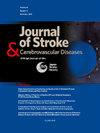Suboptimal medication possession ratio is associated with recurrent ischemic stroke in a veteran population
IF 2
4区 医学
Q3 NEUROSCIENCES
Journal of Stroke & Cerebrovascular Diseases
Pub Date : 2025-02-05
DOI:10.1016/j.jstrokecerebrovasdis.2025.108257
引用次数: 0
Abstract
Objectives
Recurrent stroke results in higher disability and mortality but might be mitigated through interventions that improve medication adherence. The medication possession ratio (MPR) is an objective proxy for adherence that may provide an individualized risk assessment for recurrent stroke.
Methods
This is a retrospective, longitudinal cohort study of patients with recent ischemic stroke or TIA referred to a Veterans Affairs vascular neurology outpatient clinic between 2010 and 2016. We calculated average MPR quartile for four medication classes used for secondary stroke prevention by reviewing pharmacy and medical records following an incident cerebral ischemic event. Traditional stroke risk factors were quantified using the Framingham Stroke Risk Profile (FSRP) score. We hypothesized that lower average MPR would relate to higher recurrent stroke risk more than FSRP or stroke etiological classification.
Results
For 255 patients with stroke or TIA, 57 (22.4 %) patients had recurrent stroke during a median follow-up period of 5.0 years (IQR 2.0). Compared to optimal average MPR, each quartile lower average MPR was associated with higher cumulative incidence of recurrent stroke (subhazard ratio 1.63, 95 %CI: 1.24 to 2.14, p<0.001) while accounting for the competing risk of death and covarying for FSRP. Neither FSRP nor stroke etiology were associated with recurrent stroke. However, higher baseline systolic blood pressure starting at 132 mm Hg was independently associated with stroke recurrence.
Conclusions
MPR is an effective proxy measurement to assess risk of recurrent stroke. Systems-based and individualized interventions to improve medication adherence are needed to reduce recurrent stroke rates in VA populations.
求助全文
约1分钟内获得全文
求助全文
来源期刊

Journal of Stroke & Cerebrovascular Diseases
Medicine-Surgery
CiteScore
5.00
自引率
4.00%
发文量
583
审稿时长
62 days
期刊介绍:
The Journal of Stroke & Cerebrovascular Diseases publishes original papers on basic and clinical science related to the fields of stroke and cerebrovascular diseases. The Journal also features review articles, controversies, methods and technical notes, selected case reports and other original articles of special nature. Its editorial mission is to focus on prevention and repair of cerebrovascular disease. Clinical papers emphasize medical and surgical aspects of stroke, clinical trials and design, epidemiology, stroke care delivery systems and outcomes, imaging sciences and rehabilitation of stroke. The Journal will be of special interest to specialists involved in caring for patients with cerebrovascular disease, including neurologists, neurosurgeons and cardiologists.
 求助内容:
求助内容: 应助结果提醒方式:
应助结果提醒方式:


